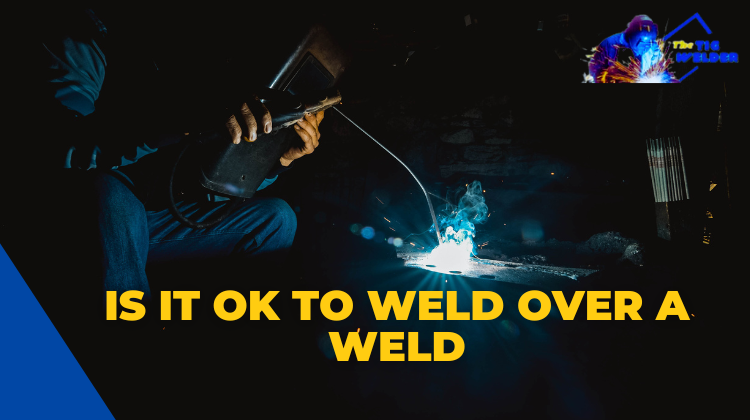Welding is a method of joining metal components by melting and fusing them using high heat and pressure. Welding is widely used in various industries to create strong, permanent connections between metal parts, including construction, manufacturing, and transportation.
There are several reasons why a welder might choose to weld over a previous weld:
- Repairing or reinforcing a previous weld: Welding over a previous weld can be used to repair a damaged, weak, or flawed weld. By adding additional weld material, the welder can strengthen the joint and improve its overall quality.
- Building up a surface for further welding: A welder may need to build up a surface to prepare it for further welding. This can be done by layering multiple welds on top of each other to create the desired thickness and shape.
- Improving appearance or smoothness: Welding over a previous weld can create a smoother, more aesthetically pleasing finish on a welded joint.
Overall, welding over a previous weld can be useful in certain situations. Still, it’s important for the welder to carefully consider the factors that may affect the quality and integrity of the final weld.

Factors to Consider Before Welding Over a Weld
There are several factors that a welder should consider before welding over a previous weld:
- Condition of the original weld: It’s important to assess the condition of the original weld to determine whether it is suitable for further welding. If the weld is damaged, weak, or flawed in some way, it may not be able to support additional weld material and could potentially fail under the stress of welding.
- Type and thickness of the materials being welded: The type and thickness of the materials being welded can affect the suitability of welding over a previous weld. Materials that are too thin or too hard may not be able to support additional weld material. At the same time, too thick materials may be difficult to penetrate and fuse properly.
- Position of the weld: The position of the weld can also impact the feasibility of welding over a previous weld. Welds in hard-to-reach or difficult-to-support positions may be more challenging and require special techniques or equipment.
By carefully considering these factors, a welder can determine whether it is safe and practical to weld over a previous weld and, if so, what techniques and equipment will be required.
Techniques for Welding Over a Weld
There are several techniques that a welder can use when welding over a previous weld:
- Repairing or reinforcing a previous weld: When repairing or reinforcing a previous weld, the welder may use a technique called “weld build-up” to add additional weld material to the joint. This can be done using a variety of welding processes, such as MIG, TIG, or Stick welding. The welder may also use a filler metal to add strength and improve the overall quality of the weld.
- Building up a surface for further welding: To build up a surface for further welding, the welder can use a technique called “weld build-up” to layer multiple welds on top of each other to create the desired thickness and shape. This can be done using a variety of welding processes, such as MIG, TIG, or Stick welding.
- Improving appearance or smoothness: To create a smoother, more aesthetically pleasing finish on a welded joint, the welder can use a technique called “weld grinding” to smooth out the surface of the weld. This can be done using a grinding wheel or other specialized tools.
Overall, the technique that a welder uses when welding over a previous weld will depend on the specific goals of the project and the condition of the original weld. It’s important for the welder to carefully consider the factors that may affect the final weld’s quality and integrity and use the appropriate techniques and equipment to ensure the best possible result.
Risks and Challenges of Welding Over a Weld
There are several risks and challenges that a welder may face when welding over a previous weld:
- Risk of cracking or weakening the original weld: Welding over a previous weld can generate high heat and pressure levels, potentially damaging or weakening the original weld. If the original weld is not in good condition or cannot support the stress of additional welding, it may crack or fail under strain.
- The difficulty of ensuring proper penetration and fusion: When welding over a previous weld, it can be challenging to ensure that the new weld material properly penetrates and fuses with the original weld. The joint may be weak and prone to failure if the new weld does not fully penetrate and fuse with the original weld.
- Need for proper technique and equipment: To ensure the quality and integrity of the final weld, the welder needs to use proper technique and equipment when welding over a previous weld. This may include using the appropriate welding process, filler metal, shielding gas, and specialized tools and techniques to ensure proper penetration and fusion.
Overall, welding over a previous weld can be useful in certain situations, but it also carries risks and challenges that must be carefully considered. Proper preparation, technique, and equipment are key to ensuring the quality and integrity of the final weld.
Conclusion
In conclusion, welding over a previous weld can be a useful technique for repairing or reinforcing a weld, building up a surface for further welding, or improving the appearance or smoothness of a welded joint. However, it’s important for the welder to carefully consider the condition of the original weld, the type and thickness of the materials being welded, and the position of the weld before proceeding. Welding over a previous weld also carries risks and challenges, such as the risk of cracking or weakening the original weld, the difficulty of ensuring proper penetration and fusion, and the need for proper technique and equipment. By carefully evaluating these factors and using the appropriate techniques and equipment, a welder can ensure the quality and integrity of the final weld.

It’s been years since I got into welding as a side hustle. It’s been so long since Doing All kinds of welds for business and pleasure as this is my hobby. Being in this field I have learned from hands-on-experience also came to know what gears work and what doesn’t. The Tig Welder is my own platform where I use to share my experience.






Leave a Reply